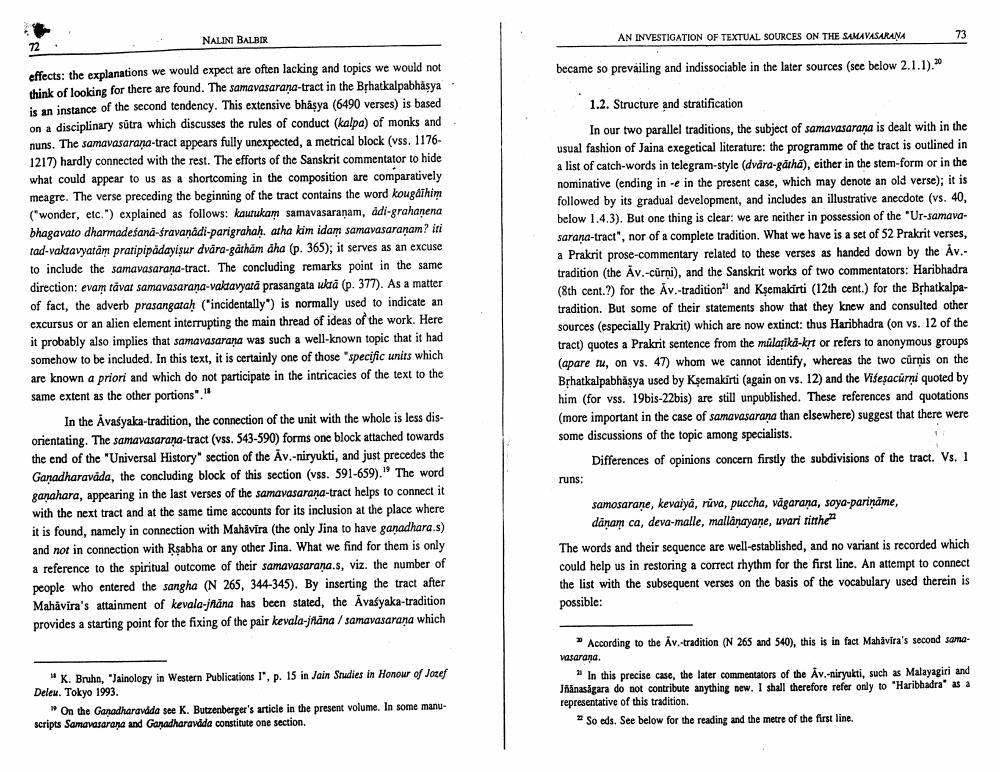Book Title: An Investigation Of Textual Sources On Samavasarana Author(s): Nalini Balbir Publisher: Nalini Balbir View full book textPage 4
________________ NALIN BALBIR AN INVESTIGATION OF TEXTUAL SOURCES ON THE SAMAVASARANA 73 became so prevailing and indissociable in the later sources (see below 2.1.1). effects: the explanations we would expect are often lacking and topics we would not think of looking for there are found. The samavasarana-tract in the Brhatkalpabhâsya is an instance of the second tendency. This extensive bhasya (6490 verses) is based on a disciplinary sutra which discusses the rules of conduct (kalpa) of monks and nuns. The samavasarana-tract appears fully unexpected, a metrical block (vss. 11761217) hardly connected with the rest. The efforts of the Sanskrit commentator to hide what could appear to us as a shortcoming in the composition are comparatively mcagre. The verse preceding the beginning of the tract contains the word kougdihim ("wonder, etc.") explained as follows: kautukam samavasaraṇam, ddi-grahanena bhagavato dharmadesand-sravanádi-parigrahah. atha kim idam samavasaranam? iti tad-vakravyatam pratipipadayisur dvära-gåtham dha (p. 365); it serves as an excuse to include the samavasarana-tract. The concluding remarks point in the same direction: evam tavat samavasarana-vaktayyarā prasangata uka (p. 377). As a matter of fact, the adverb prasangatah ('incidentally') is normally used to indicate an excursus or an alien element interrupting the main thread of ideas of the work. Here it probably also implies that samavasarana was such a well-known topic that it had somehow to be included. In this text, it is certainly one of those specific units which are known a priori and which do not participate in the intricacies of the text to the same extent as the other portions"." In the Avasyaka-tradition, the connection of the unit with the whole is less disorientating. The samavasarana-tract (vss. 543-590) forms one block attached towards the end of the Universal History" section of the Av.-niryukti, and just precedes the Ganadharavada, the concluding block of this section (vss. 591-659)." The word ganahara, appearing in the last verses of the samavasarana-tract helps to connect it with the next tract and at the same time accounts for its inclusion at the place where it is found, namely in connection with Mahavira (the only Jina to have ganadhara.s) and nor in connection with Rşabha or any other Jina. What we find for them is only a reference to the spiritual outcome of their samavasarana.s, viz. the number of people who entered the sangha (N 265, 344-345). By inserting the tract after Mahavira's attainment of kevala-jfāna has been stated, the Avasyaka-tradition provides a starting point for the fixing of the pair kevala-Mäna / samavasarana which 1.2. Structure and stratification In our two parallel traditions, the subject of samavasarana is dealt with in the usual fashion of Jaina exegetical literature: the programme of the tract is outlined in a list of catch-words in telegram-style (dvara-gāzha), either in the stem-form or in the nominative (ending in -e in the present case, which may denote an old verse); it is followed by its gradual development, and includes an illustrative ancodote (vs. 40, below 1.4.3). But one thing is clear: we are neither in possession of the "Ur-samavasarana-tract", nor of a complete tradition. What we have is a set of 52 Prakrit verses, a Prakrit prose-commentary related to these verses as handed down by the Av.. tradition (the Av.-cùrni), and the Sanskrit works of two commentators: Haribhadra (8th cent.?) for the Av. tradition and Ksemakirti (12th cent.) for the Brhatkalpatradition. But some of their statements show that they knew and consulted other sources (especially Prakrit) which are now extinct: thus Haribhadra (on vs. 12 of the tract) quotes a Prakrit sentence from the mularika-kyt or refers to anonymous groups (apare tu, on vs. 47) whom we cannot identify, whereas the two cúrnis on the Brhatkalpabhasya used by Ksemakirti (again on vs. 12) and the Wisesacúrni quoted by him (for vss. 19bis-22bis) are still unpublished. These references and quotations (more important in the case of samavasarana than elsewhere) suggest that there were some discussions of the topic among specialists. Differences of opinions concern firstly the subdivisions of the tract. Vs. 1 runs: samosarane, kevaiya, niva, puccha, vägarana, soya-pariname, danam ca, deva-malle, mallanayane, uvari titthem The words and their sequence are well-established, and no variant is recorded which could help us in restoring a correct rhythm for the first line. An attempt to connect the list with the subsequent verses on the basis of the vocabulary used therein is possible: K. Bruhn, Jainology in Western Publications I'. p. 15 in Jain Srudies in Honour of Jozef Deleu. Tokyo 1993. "On the Ganadharavida see K. Butzenberger's article in the present volume. In some manuscripts Samarasarana and Ganadharavada constitute one section, According to the Av.-tradition (N 265 and 540), this is in fact Mahavira's second samavasarana. * In this precise case, the later commentators of the Av. nirvukti, such as Malayagiri and Jhānasagara do not contribute anything new. I shall therefore refer only to "Haribhadra as a representative of this tradition. So eds. See below for the reading and the metre of the first line.Page Navigation
1 2 3 4 5 6 7 8 9 10 11 12 13 14 15 16 17 18 19 20
